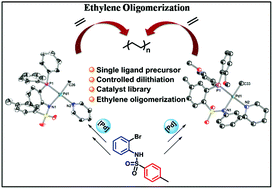Controlled di-lithiation enabled synthesis of phosphine-sulfonamide ligands and implications in ethylene oligomerization†‡
Abstract
Catalyst design for ethylene oligomerization has attracted significant interest. Herein, we report the synthesis of phosphine-sulfonamide-derived palladium complexes and examine their performance in ethylene oligomerization. Arresting a dilithiation intermediate of N-(2-bromophenyl)-4-methylbenzenesulfonamide (1) at −84 °C selectively produced N-(2-(bis(2-methoxyphenyl)phosphanyl)phenyl)-4-methylbenzenesulfonamide (L1A). However, the same reaction at −41 °C delivered a different ligand; 2-(bis(2-methoxyphenyl)phosphanyl)-4-methyl-N-phenylbenzenesulfonamide (L2A). The generality of our strategy has been demonstrated by preparing N-(2-(diphenylphosphanyl)phenyl)-4-methylbenzenesulfonamide (L1B) and 2-(diphenylphosphanyl)-4-methyl-N-phenylbenzenesulfonamide (L2B). Subsequently, L1A and L1B were treated with a palladium precursor to yield 5-membered complexes C1 and C2, respectively. In contrast, L2A upon treatment with palladium produced a 6-membered metal complex C3. Thus, a small library of 7 palladium complexes (C1–C7) were synthesized by varying the donor moiety (pyridine, DMSO, and acetonitrile). The identity of palladium complexes was unambiguously ascertained using a combination of spectroscopic and analytical methods, including single-crystal X-ray diffraction. The performance of the complexes C1–C7 was investigated in ethylene oligomerization and almost all of them were found to be active. The resultant ethylene oligomers were characterized using 1H and 13C NMR, MALDI-ToF-MS, and GPC. Detailed screening of reaction parameters revealed 100 °C and 40 bars ethylene to be optimal conditions. Complex C5 outperformed other complexes and produced ethylene oligomers with a molecular weight of 1000–1900 g mol−1.



 Please wait while we load your content...
Please wait while we load your content...